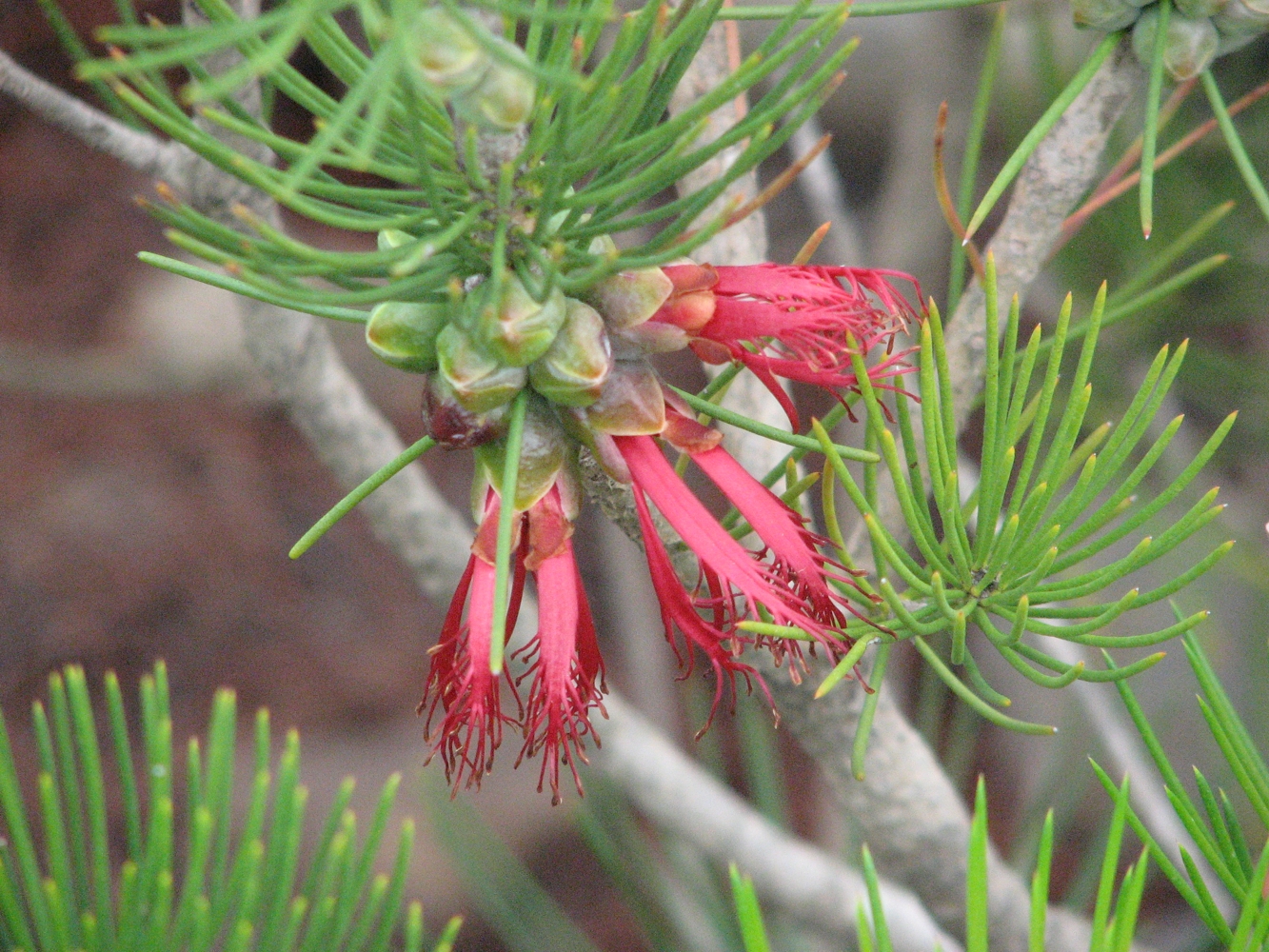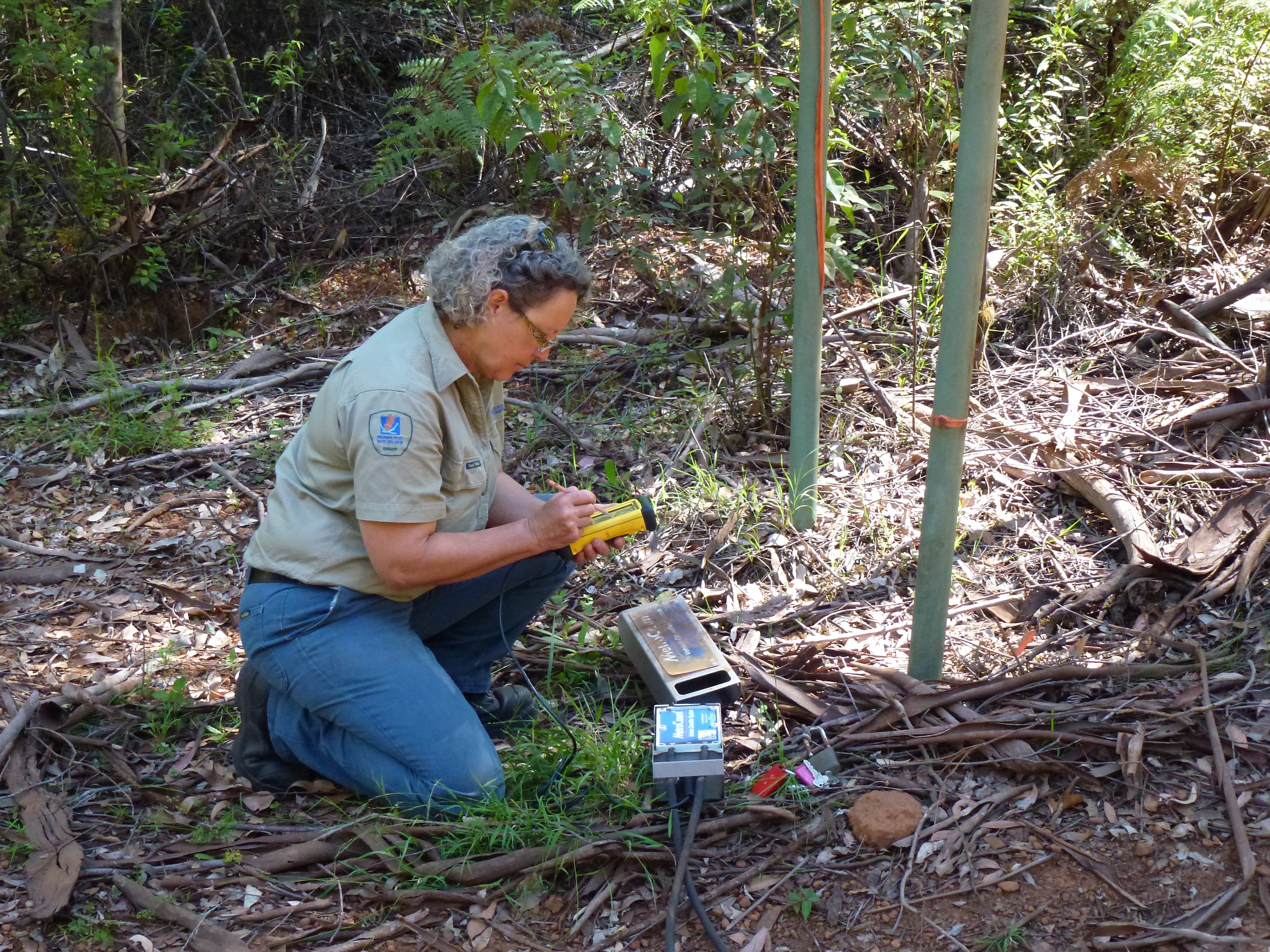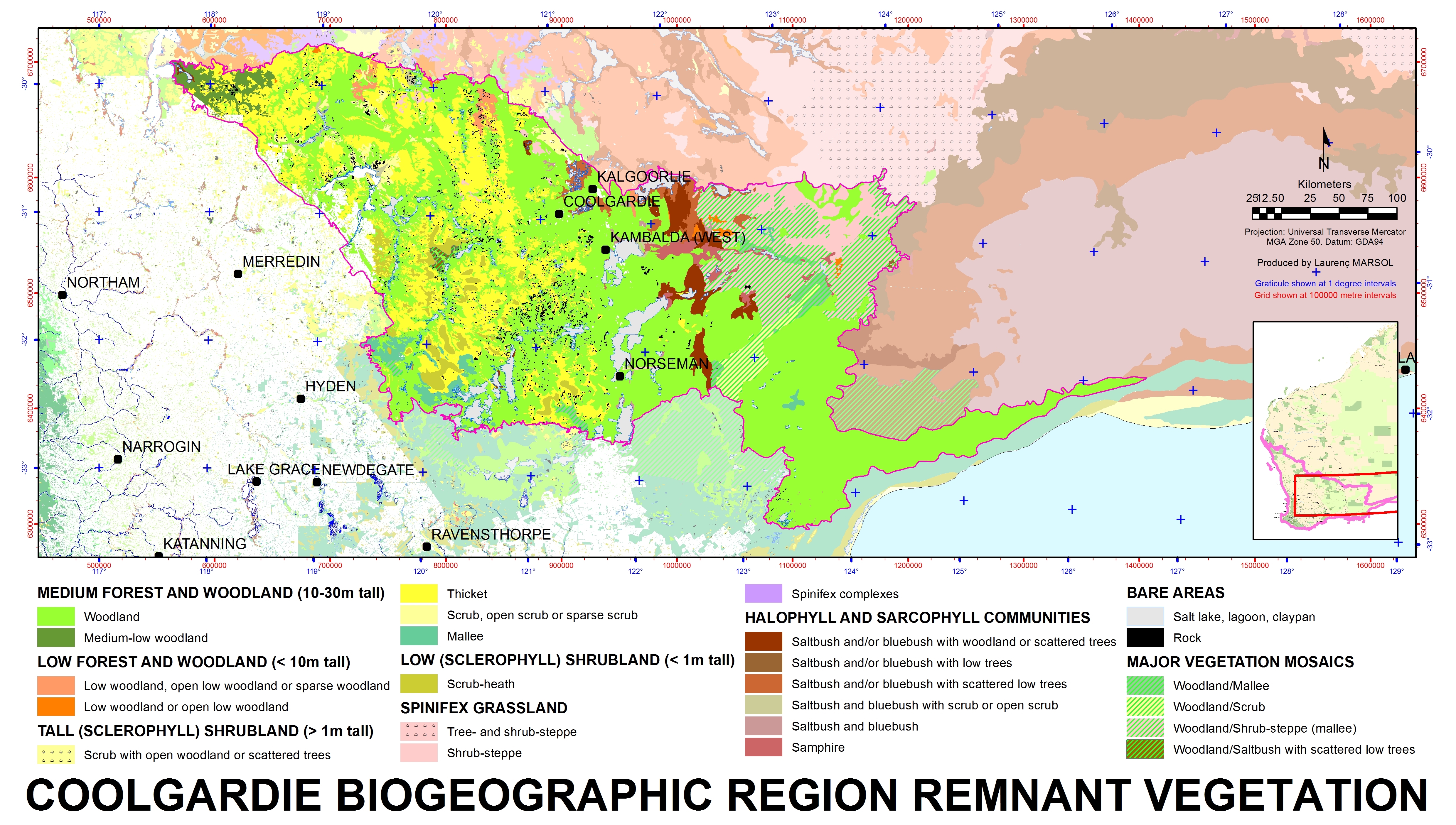|
Calothamnus Quadrifidus Subsp. Seminudus
''Calothamnus quadrifidus'' subsp. ''seminudus'' is a plant in the myrtle family, Myrtaceae and is endemic to the south-west of Western Australia. It is similar to other subspecies of ''Calothamnus quadrifidus'' except that its leaves are linear and somewhat rough and scaly and the stamen bundles are relatively long. Description ''Calothamnus quadrifidus'' subsp. ''seminudus'' is an erect or spreading shrub which sometimes grows to a height of and lacks a lignotuber. Its leaves are crowded, flat and linear or very narrow egg-shaped with the narrower end towards the base. They are long and wide. The flowers are red and arranged in clusters, usually on one side of the stem amongst the older leaves. The stamens are arranged in 4 claw-like bundles, each about long. The lower half of the outer surface of the floral cup (the hypanthium) is hairy while the upper part is glabrous. Flowering mainly occurs from August to December and is followed by fruits which are woody, roughly sphe ... [...More Info...] [...Related Items...] OR: [Wikipedia] [Google] [Baidu] |
Alex George (botanist)
Alexander Segger George (born 4 April 1939) is a Western Australian botanist. He is the authority on the plant genera ''Banksia'' and ''Dryandra''. The "bizarre" Restionaceae genus '' Alexgeorgea'' was named in his honour in 1976. Early life Alex Segger George was born in Western Australia on 4 April 1939. Career George joined the Western Australian Herbarium as a laboratory assistant at the age of twenty in 1959. He worked under Charles Gardner for a year before the latter's retirement, and partly credits him with rekindling an interest in banksias. In 1963 he graduated with a Bachelor of Arts from the University of Western Australia, and the following year added a botany major. Continuing at the Western Australian Herbarium as a botanist, in 1968 he was seconded as Australian Botanical Liaison Officer at the Royal Botanic Gardens in London. George also has an interest in history, especially historical biography of naturalists in Western Australia. He has published a number ... [...More Info...] [...Related Items...] OR: [Wikipedia] [Google] [Baidu] |
Lake King, Western Australia
Lake King is a town in the eastern Wheatbelt region of Western Australia, from Perth along State Route 40 between Kelmscott and Ravensthorpe. As of 2016, the town had a population of 95. The 2011 census recorded both the population of the town and the surrounding area for a population of 332. Lake King is named after a nearby lake which in turn was named after the Surveyor General of Western Australia, Henry Sandford King, by Marshall Fox, District Surveyor (Narrogin). In 1926, following completion of an initial land classification survey of the Lake King district that defined 230,000 acres as suitable for settlement, a large official inspection party was led by Surveyor General John Percy Camm, Sydney Stubbs ( MLA Wagin), Edwin Wilkie Corboy (MLA Yilgan), and James Cornell ( MLC South Province). The area was surveyed and access roads built during 1927, and land released in 1928 at prices from 4/6 to 16/- per acre. The town struggled through the depression but thrived in t ... [...More Info...] [...Related Items...] OR: [Wikipedia] [Google] [Baidu] |
Myrtales Of Australia
The Myrtales are an order of flowering plants placed as a sister to the eurosids II clade as of the publishing of the ''Eucalyptus grandis'' genome in June 2014. The APG III system of classification for angiosperms still places it within the eurosids. This finding is corroborated by the placement of the Myrtales in the Malvid clade by the One Thousand Plant Transcriptomes Initiative. The following families are included as of APGIII: * Alzateaceae S. A. Graham * Combretaceae R. Br. ( leadwood family) * Crypteroniaceae A. DC. * Lythraceae J. St.-Hil. ( loosestrife and pomegranate family) * Melastomataceae Juss. (including Memecylaceae DC.) * Myrtaceae Juss. (myrtle family; including Heteropyxidaceae Engl. & Gilg, Psiloxylaceae Croizat) * Onagraceae Juss. ( evening primrose and Fuchsia family) * Penaeaceae Sweet ex Guill. (including Oliniaceae Arn., Rhynchocalycaceae L. A. S. Johnson & B. G. Briggs) * Vochysiaceae A. St.-Hil. The Cronquist system gives essentially the same c ... [...More Info...] [...Related Items...] OR: [Wikipedia] [Google] [Baidu] |
Calothamnus
''Calothamnus'' is a genus of shrubs in the family Myrtaceae and is endemic to the south-west of Western Australia. The common names one-sided bottlebrush or claw flower are given to some species due to their having the flowers clustered on one side of the stem or because of the claw-like appearance of their flowers. ''Calothamnus'' species are generally medium to tall woody shrubs with crowded leaves. In most species the leaves are crowded and linear in shape, and the flowers are usually arranged in dense clusters. The petals are small and fall off the flower soon after it opens but the stamens are long, numerous and usually bright red. Description Plants in the genus ''Calothamnus'' are medium to tall shrubs, sometimes low-growing ground covers. The leaves are linear or narrow lance-shaped with the narrower end towards the base, usually glabrous and have distinct oil glands. The flowers are in small groups or dense spikes on leafless, older stems or between the leaves on ... [...More Info...] [...Related Items...] OR: [Wikipedia] [Google] [Baidu] |
Department Of Parks And Wildlife (Western Australia)
The Department of Parks and Wildlife (DPaW) was the department of the Government of Western Australia responsible for managing lands described in the ''Conservation and Land Management Act 1984'' and implementing the state's conservation and environment legislation and regulations. The minister responsible for the department was the Minister for the Environment (Western Australia), Minister for the Environment. History The Department of Environment and Conservation (Western Australia), Department of Environment and Conservation (DEC) was separated on 30 June 2013, forming the Department of Parks and Wildlife (DPaW) and the Department of Environment Regulation (DER), both of which commenced operations on 1 July 2013. DPaW focused on managing multiple use state forests, national parks, marine parks and reserves. DER focused on environmental regulation, approvals and appeals processes, and pollution prevention. It was announced on 28 April 2017 that the Department of Parks and Wi ... [...More Info...] [...Related Items...] OR: [Wikipedia] [Google] [Baidu] |
Mallee Woodlands And Shrublands
Mallee Woodlands and Shrublands is one of 32 List of Major Vegetation Groups in Australia, Major Vegetation Groups defined by the Australian Government Department of the Environment and Energy. Description "Mallee (habit), Mallee" refers to the growth habit of a group of (mainly) eucalypt species that grow to a height of , have many stems arising from a lignotuber and have a leafy canopy that shades 30–70% of the ground. The term is also applied to a vegetation association where these mallee eucalypts grow, on land that is generally flat without hills or tall trees and where the climate is semi-arid. Of the 32 Major Vegetation Groups classified under the National Vegetation Information System, "Mallee Woodlands and Shrublands" (MVG14): * are semi-arid areas dominated by mallee eucalypts; * may also have co-dominant species of ''Callitris'', ''Melaleuca'', ''Acacia'' and ''Hakea''; * have an open tree or shrub layer with more than 10% foliage cover and more than 20% Crown (bota ... [...More Info...] [...Related Items...] OR: [Wikipedia] [Google] [Baidu] |
Laterite
Laterite is both a soil and a rock type rich in iron and aluminium and is commonly considered to have formed in hot and wet tropical areas. Nearly all laterites are of rusty-red coloration, because of high iron oxide content. They develop by intensive and prolonged weathering of the underlying parent rock, usually when there are conditions of high temperatures and heavy rainfall with alternate wet and dry periods. Tropical weathering (''laterization'') is a prolonged process of chemical weathering which produces a wide variety in the thickness, grade, chemistry and ore mineralogy of the resulting soils. The majority of the land area containing laterites is between the tropics of Tropic of Cancer, Cancer and Tropic of Capricorn, Capricorn. Laterite has commonly been referred to as a soil type as well as being a rock type. This and further variation in the modes of conceptualizing about laterite (e.g. also as a complete weathering profile or theory about weathering) has led to c ... [...More Info...] [...Related Items...] OR: [Wikipedia] [Google] [Baidu] |
Mallee (biogeographic Region)
Mallee, also known as Roe Botanical District, is a biogeographic region in southern Western Australia. Located between the Esperance Plains, Avon Wheatbelt and Coolgardie bioregions, it has a low, gently undulating topography, a semi-arid mediterranean climate, and extensive ''Eucalyptus'' mallee vegetation. It has an area of . About half of the region has been cleared for intensive agriculture. Recognised as a region under the Interim Biogeographic Regionalisation for Australia (IBRA), it was first defined by John Stanley Beard in 1980. Geography and geology The Mallee region has a complex shape with tortuous boundaries, but may be roughly approximated as the triangular area south of a line from Bruce Rock to Eyre, but not within 40 kilometres (25 mi) of the south coast, except at its eastern limits. It has an area of about 79000 square kilometres (31000 mi²), making it about a quarter of the South West Botanic Province, 3% of the state, and 1% of Australia. I ... [...More Info...] [...Related Items...] OR: [Wikipedia] [Google] [Baidu] |
Coolgardie (biogeographic Region)
Coolgardie is an Australian bioregion consisting of an area of low hills and plains of infertile sandy soil in Western Australia. It has an area of . It includes much of the Great Western Woodlands. Location and description This is a transition zone between the Mediterranean climate of Australia's south-west coast and the country's dry interior. The poor soil makes it unsuitable for agriculture but Coolgardie has been a gold and nickel mining area. It is bounded on the north by the arid Murchison bioregion, characterised by open Mulga woodlands and steppe. The low shrublands of the arid Nullarbor Plain lie to the east. The Mallee bioregion adjoins Coolgardie on the south. The Avon Wheatbelt bioregion is to the west. The Coolgardie bioregion, together with the coastal Hampton bioregion to the southeast, constitute the Coolgardie woodlands ecoregion defined by the World Wildlife Fund. Flora and fauna The low hills are home to woodland of endemic species of eucalyptus whil ... [...More Info...] [...Related Items...] OR: [Wikipedia] [Google] [Baidu] |
Avon Wheatbelt
The Avon Wheatbelt is a bioregion in Western Australia. It has an area of . It is considered part of the larger Southwest Australia savanna ecoregion. Geography The Avon Wheatbelt bioregion is mostly a gently undulating landscape with low relief. It lies on the Yilgarn Craton, an ancient block of crystalline rock, which was uplifted in the Tertiary and dissected by rivers. The craton is overlain by laterite deposits, which in places have decomposed into yellow sandplains, particularly on low hills. Steep-sided erosional gullies, known as breakaways, are common. Beecham, Brett (2001). "Avon Wheatbelt 2 (AW2 - Re-juvenated Drainage subregion)" in ''A Biodiversity Audit of Western Australia’s 53 Biogeographical Subregions in 2002''. Department of Conservation and Land Management, Government of Western Australia, November 2001. Accessed 15 May 2022/ref> In the south and west (the Katanning subregion), streams are mostly perennial, and feed rivers which drain westwards to empty i ... [...More Info...] [...Related Items...] OR: [Wikipedia] [Google] [Baidu] |
Peak Charles National Park
Peak Charles National Park is a national park in Western Australia, east of Perth and north west of Esperance. The park is named for one of the main features, Peak Charles, which is an ancient granite peak with an elevation of that dominates the park along with its neighbour Peak Eleanora. Both afford excellent views over the park, which is primarily composed of dry sand plain heaths and salt lake systems. It is located within the IBRA sub region of the Eastern Mallee and has a number of rare plants within its boundaries including '' Gastrolobium acrocaroli''. No entry fee applies to enter the park but there are few facilities available to tourists. A car park, campground and toilets are available. A looped walk trail to a lookout at the top of Peak Charles is also available which requires rock scrambling. See also * Protected areas of Western Australia Western Australia is the second largest country subdivision in the world. It contains no fewer than separate Prot ... [...More Info...] [...Related Items...] OR: [Wikipedia] [Google] [Baidu] |
Bremer Range
Bremer may refer to: People *Bremer (surname) *Bremer Ehrler (born 1914), American politician * Bremer (born 1997), Brazilian footballer Places ;Australia *Bremer Bay, Western Australia *Bremer Marine Park *Bremer Island * Bremer River (other) ;USA * Bremer, Iowa, an unincorporated community *Bremer County, Iowa *Bremers Lake, a lake in McLeod County, Minnesota Other uses *Bremer SV, a German football club *ATSV 1860 Bremen, a former German football club, also known as Bremer SC *The Bremer Institute of TAFE, an Australian TAFE institute *Bremer 25, an American sailboat design *Bremer Straßenbahn AG, German public transport provider *Bremer Vulkan, a German shipbuilding company *Bremer wall, used for protection by American forces in Iraq *The Report of the National Commission on Terrorism, also known as the Bremer Commission *Stadion an der Bremer Brücke, a German sports stadium See also * Brehmer * Bremmer (other) * Bremen (other) Bremen is a city ... [...More Info...] [...Related Items...] OR: [Wikipedia] [Google] [Baidu] |




